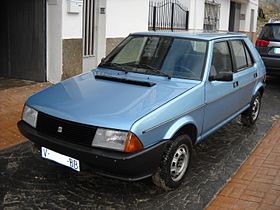SEAT Ronda
| SEAT Ronda (022A) | |
|---|---|
 |
|
| Overview | |
| Manufacturer | SEAT |
| Also called | SEAT Málaga hatchback |
| Production |
|
| Assembly | Spain |
| Body and chassis | |
| Class | Small family car |
| Body style | 5-door hatchback |
| Related |
SEAT Málaga Fiat Ritmo |
| Dimensions | |
| Wheelbase | 2,448 mm (96.4 in) |
| Length | 4,011 mm (157.9 in) |
| Width | 1,650 mm (65 in) |
| Height | 1,400 mm (55 in) |
| Chronology | |
| Predecessor | SEAT Ritmo |
| Successor | SEAT Ibiza |
The SEAT Ronda (codenamed 022A) was a small family car produced by the Spanish automaker SEAT from 1982 to 1986, and styled by Rayton Fissore in collaboration with the Technical Centre in Martorell. The Ronda was also briefly sold in the United Kingdom as the SEAT Málaga hatchback. 177,869 Rondas were built in total.
The SEAT Ronda was a restyled SEAT Ritmo which in its turn derived from the Fiat Ritmo. However, in 1983 the Arbitration Chamber of Paris (subsequent to the acrimonious split between FIAT and SEAT) judged that the differences between those cars were important enough so as not to consider the Ronda to be a rebadged Ritmo. The most visible external design differences between a Ritmo and a Ronda are rectangular headlights on the Ronda in place of the round ones featured on the Ritmo, different tail lights and panels, and changed door handles. Mechanically, there were also some minor differences, mostly due to the use of Spanish-built engines and other parts.
The interior was more comfortable than that of the original Ritmo, with a different dashboard with a more complete instrumentation. The seats were deeper and more comfortable, while the door panels were improved and the sound dampening was increased. The Spanish-made transmission was only available in a five-speed manual.
The Ronda featured a boot capacity of 370 litres which could be increased to 1250 litres by folding rear seats. It was introduced with locally built engines from the 124 series or a larger twin cam 1.6 (Crono 100), as well as a 1.7 liter diesel unit. Later, a version of Fiat's two-liter engine with a Porsche-developed head was also installed in the rare Ronda Crono 2.0 model. Only 800 of these were built. After a mid-1984 facelift, the Ronda received the "System Porsche" petrol engines which were developed for the Ibiza. The car was now called the Ronda P and early ones carried a stylized "P" on the rear side.
The engines were:
Ronda (Petrol, 1982-1984)
Ronda P (Petrol, 1984-1986)
Diesel (1982-1986)
1982 saw the end of almost 30 years of co-operation between SEAT and the automaker Fiat. In order to conform with the end of partnership agreement signed by the two automakers, SEAT had to quickly restyle its entire model range to be able to offer its models on sale, distinguishing its cars from those of the Italian firm. This was marked by a change in SEAT's brand logo and the first car launched without Fiat involvement, the SEAT Ronda, appeared that same year.
...
Wikipedia
